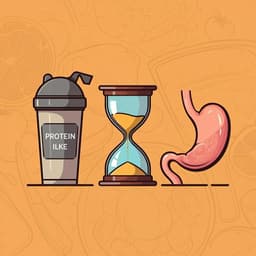
Health and Fitness
Interindividual variability in appetitive sensations and relationships between appetitive sensations and energy intake
E. Cheon and R. D. Mattes
This captivating study by Eunjin Cheon and Richard D. Mattes examines the intriguing stability of hunger, fullness, and thirst ratings over 17 weeks among 97 adults. The research uncovers the weak yet fascinating links between these sensations and individual eating patterns while revealing how energy intake plays a predominant role in influencing our appetitive experiences.
~3 min • Beginner • English
Introduction
The study addresses whether mean daily appetitive sensations (hunger, fullness, thirst) exhibit reliable inter-individual differences over extended periods and whether such differences relate to energy intake (EI), eating patterns, and adiposity risk. AS are presumed drivers of EI and fluctuate over hours; sustained biases might predispose to positive or negative energy balance and weight change. Prior short-term studies suggest reliable inter-individual differences, but long-term stability and implications remain unclear. The authors hypothesized that marked and reliable individual differences in AS exist and examined the directionality of relationships between AS and eating patterns/EI. A further aim evaluated whether individual characteristics (BMI, age, sex) account for variability in AS or modify AS–diet associations, given mixed evidence in prior literature.
Literature Review
The introduction and discussion reference prior work indicating: AS fluctuate over short time scales and have been targeted to manage body weight; earlier observational and intervention trials reported consistent inter-individual differences in AS across days and meals; evidence on the association of AS with BMI, sex, and age is mixed, with many studies finding no robust differences; eating frequency and portion size have uncertain effects on appetite and body weight, with large datasets and trials often not supporting benefits of increased eating frequency; overfeeding and weight loss studies show inconsistent coupling between AS and EI. These mixed findings motivate the present longer-term, naturalistic assessment of AS stability and their relation to EI and eating patterns.
Methodology
Design: 17-week observational study with data collection at weeks 1, 9, and 17 on two randomized, non-consecutive weekdays and one weekend day per timepoint (total 9 days per participant). Participants: Healthy adults aged 18–64 years, weight-stable (<2.5 kg change over prior 3 months), not on appetite-affecting medications, and not planning lifestyle changes. Recruitment targeted three age groups and two BMI categories within each. N enrolled=109; completers=90; partial completers=7. Screening included demographics, questionnaires on eating traits, and anthropometrics; all participants received appetite lexicon training (definitions of hunger, fullness, desire to eat, and prospective consumption), passed an online quiz (≥90%). Measures: - Appetitive sensations: Hourly waking ratings of hunger, fullness, and thirst via web-based VAS (0–100%) on selected days at weeks 1, 9, 17. Entries time-stamped; accepted if within ±5 min of each target hour; rescheduled if protocol deviations occurred. - Physical activity: Free-living energy expenditure via ActivityTracker Pedometer app (steps, calories, active time, distance) on the same days; participants submitted screenshots. - Dietary intake: 24-h recall via ASA24 (2020–2022) the day after AS ratings; system prompted for completeness; plausibility assessed using Goldberg cutoffs. Data Analysis: Aim 1 (stability and variability): One-way ANOVA to partition within- and between-individual variance in AS across 9 days; tertiles based on total mean AS examined for differences in EI, eating frequency, portion size, age, BMI (Levene’s test; Welch’s ANOVA if variances unequal). Seasonal effects assessed via one-way ANOVA across Dec–Feb, Mar–May, Jun–Aug, Sep–Nov. Pearson correlations computed among weekly mean AS (weeks 1, 9, 17). Aim 2 (relationships and directionality): Pearson correlations between daily mean AS and EI, portion size, BMI; Spearman correlations for AS and eating frequency (categorical). Generalized regression for weekday vs weekend AS; linear mixed model with week as random effect and individual nested within week. Generalized regression for total mean AS vs EI, adjusting for age, gender, BMI, physical activity. Time-series directionality via cross-correlation functions (CCF) between hourly EI and AS, and between hourly drinking events and thirst; data pre-whitened to reduce autocorrelation bias. Wilcoxon signed-rank tests compared AS changes 1 h before vs 1 h after meals. Structural equation modeling (SEM) path analyses tested effects of daily EI on daily mean AS while including eating patterns (eating frequency, portion size) and BMI; data min–max scaled; model fit assessed by chi-square p>0.05, NFI>0.95, RFI/IFI/TLI/CFI>0.9, RMSEA<0.05; physical activity was tested initially but excluded for nonsignificance. Aim 3 (individual characteristics): Contingency tests examined distributions of sex and BMI categories across AS tertiles; age compared across tertiles. Significance at two-tailed p<0.05 with Tukey adjustments. Software: SAS 9.4 (correlation, ANOVA, regression, WSR, contingency), SPSS v28 (CCF), AMOS v26 (SEM).
Key Findings
- Stability and inter-individual variability: Marked inter-individual differences in daily mean AS across 17 weeks (ANOVA p<0.0001 for hunger, fullness, thirst). Between-individual variance greatly exceeded within-individual variance: hunger within=52.7 (7.3%) vs between=670.1 (92.7%); fullness within=69.0 (5.1%) vs between=1285.6 (94.9%); thirst within=59.4 (3.3%) vs between=1738.9 (96.7%). Daily mean ranges across individuals: hunger 2.9–62.5%; fullness 13.4–87.7%; thirst 2.5–87.6%. Weekly mean AS showed strong test–retest correlations: hunger r=0.72 (w1–w9), 0.67 (w1–w17), 0.77 (w9–w17); fullness r=0.74, 0.71, 0.81; thirst r=0.82, 0.81, 0.88 (all p<0.001). - Temporal/day-type/seasonal effects: No significant differences between weekdays and weekends for daily mean AS. No seasonal effect on hunger or thirst; a small difference in fullness between Jun–Aug and Dec–Feb (Tukey p=0.02; −4.11%). Weak correlations among AS: hunger vs fullness r=−0.07 (p=0.04); hunger vs thirst r=0.47 (p<0.001); fullness vs thirst r=0.02 (p=0.6). - EI and AS tertiles: Mean EI across nine test days did not differ by tertiles of hunger (2098±90, 1888±65, 1848±99 kcal), fullness (1856±95, 2107±92, 1865±85 kcal), or thirst (1958±85, 1915±93, 1960±101 kcal); results unchanged after adjusting for age, sex, BMI, physical activity. EI and BMI were positively associated overall (r=0.17, p<0.01). Slopes of EI–BMI regressions varied by AS tertiles: for hunger, slopes 2.21 (p=0.74), 33.97 (p<0.0001), 37.45 (p<0.0001) across 1st–3rd tertiles; for fullness, 30.96 (p<0.0001), 18.14 (p=0.03), 18.72 (p=0.24); for thirst, 3.96 (p=0.61), 25.36 (p<0.0001), 48.13 (p<0.0001). - Directionality (CCF): EI led AS at −1 h lag with larger effects than AS leading EI at +1 h lag. Hunger–EI CCF: −0.255 at −1 h (largest; reduction in hunger), +0.052 at +1 h (p<0.05). Fullness–EI CCF: +0.228 at −1 h (increase in fullness), −0.042 at +1 h (p<0.05). Thirst–EI CCF: −0.082 at −1 h; +0.013 at +1 h (p<0.05). Thirst–drinking events CCF: −0.100 at −1 h; correlation at +1 h with EI non-significant (−0.001, p>0.05). AS changes 1 h after meals exceeded changes 1 h before: hunger before +4.32% vs after −0.96%; fullness +2.63% vs +8.06%; thirst +3.27% vs −5.52% (all p<0.0001). - Path analysis (SEM): Daily EI had a significant but weak effect on daily mean hunger (p<0.001); no significant effects on fullness or thirst. Physical activity had no significant effects and was excluded from final models. - Eating patterns correlations: Eating frequency negatively correlated with hunger (r=−0.094, p<0.01) and thirst (r=−0.10, p<0.01); no significant relation with fullness. Portion size positively correlated with fullness (r=0.092, p<0.01); no significant relation with hunger or thirst. - Individual characteristics: No robust associations of AS with sex or BMI categories; an age difference was observed only for hunger tertiles (3rd tertile older than 2nd: 37.8±2.3 vs 29.1±1.7 years; p=0.008); otherwise, age, sex, BMI distributions did not differ across AS tertiles.
Discussion
Findings confirm that hunger, fullness, and thirst exhibit substantial inter-individual variability yet are highly stable within individuals over 17 weeks in free-living conditions. Despite common assumptions that AS drive intake, multiple analyses (CCF, before/after meal changes, SEM) show EI more strongly influences subsequent AS than AS predict EI, and the magnitudes of these associations are small. Consequently, AS may be poor predictors of EI under relative energy balance. Relationships between AS and eating patterns (frequency, portion size) were statistically significant but very weak, aligning with prior literature questioning the efficacy of manipulating eating frequency or portion size for weight management. Demographic factors (age, sex, BMI) showed minimal or inconsistent associations with AS, suggesting environmental and situational influences may overshadow these characteristics. The asymmetric directionality (intake leading sensations) could have clinical implications: inadequate post-meal reductions in hunger may facilitate more frequent unplanned eating and higher daily EI. The generalizability of these findings to states of pronounced positive or negative energy balance is uncertain, as literature shows mixed coupling of AS and intake during weight loss or overfeeding; further research is needed there.
Conclusion
Appetitive sensations of hunger, fullness, and thirst are stable traits within individuals but vary widely between individuals. Under conditions of relative energy balance, AS show only weak associations with eating patterns and EI, and EI more strongly drives AS than the reverse, limiting the predictive value of AS for intake. No robust links were found between AS and age, sex, or BMI. Future research should evaluate whether AS–intake coupling strengthens under marked energy imbalance, include additional appetitive constructs (desire to eat, prospective consumption), and clarify environmental and behavioral factors that modulate the intake-to-sensation pathway.
Limitations
- Appetitive constructs were limited to hunger, fullness, and thirst; desire to eat and prospective consumption were not measured. - Observational design under free-living conditions introduces potential unmeasured confounders affecting AS and intake. - Self-reported dietary intake exhibited substantial mis-reporting (68 under-reporters, 20 over-reporters by Goldberg criteria), potentially attenuating AS–EI associations, though directionality was supported across analyses.
Related Publications
Explore these studies to deepen your understanding of the subject.







